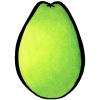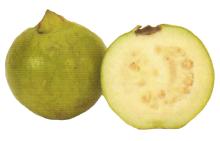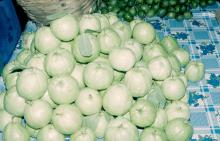Maturity and Quality
Guava fruits are picked at the mature-green stage (color change from dark- to light-green) in some countries where consumers eat them at that stage. In countries where consumers prefer ripe guava, the fruits are picked at the firm-yellow to half-ripe (softer) stage for long-distance transport or at the fully-ripe (yellow and soft) stage for local markets.
- Color is a good indicator of ripeness stage
- Size and shape may be important in some markets
- Freedom from defects, insects, and decay
- Firmness and extent of gritty texture due to the presence of stone cells (sclereids)
- Flesh color depends on cultivar and can be white, yellow, pink, or red
- Amount of seeds in the flesh (the fewer the better)
- Aroma intensity
- Soluble solids and acidity
- Guava is one of the richest sources of vitamin C (200 to 400 mg per 100g fresh weight) and some cultivars are also rich in vitamin A
Postharvest Handling and Storage
- 8-10°C (46-50°F) for mature-green and partially-ripe guavas (storage potential = 2-3 weeks)
- 5-8°C (41-46°F) for fully-ripe guavas (storage potential = 1 week)
| Temperature | ml CO2/kg·hr |
|---|---|
| 10°C (50°F) | 4-30 |
| 20°C (68°F) | 10-70 |
Ethylene at 100ppm for 1-2 days can accelerate ripening of mature-green guavas to full-yellow stage at 15-20°C (59-68°F) and 90-95% relative humidity. This treatment results in more uniform ripening, which is more important for guavas destined for processing. Immature-green guavas do not ripen properly and develop 'gummy' texture.
90-95%
Guava is a climacteric fruit. Rates of respiration and ethylene production depend upon cultivar and maturity/ripeness stage. Ethylene production at 20°C (68°F) ranges from 1 to 20 µl/kg·hr.
The limited research on guava indicates that 2-5% oxygen levels may delay ripening of mature-green and partially-ripe guavas kept at 10°C (50°F). Tolerance to elevated carbon dioxide levels has not been determined.
Disorders
Chilling injury. Symptoms include failure of mature-green or partially-ripe guavas to ripen, browning of the flesh and, in severe cases, the skin, and increased decay incidence and severity upon transfer to higher temperatures. Fully-ripe guavas are less sensitive to chilling injury than mature-green guavas and may be kept for up to a week at 5°C (41°F) without exhibiting chilling injury symptoms.
External (skin) and Internal (flesh) browning. Guavas are sensitive to physical damage during harvesting and handling all the way to the consumer. Symptoms include skin abrasions and browning of bruised areas.
Sun scald. Guavas exposed to direct sun light may be scalded. In some countries, paper bags are used to cover guava fruits and protect them from solar radiation and insect infestation while on the tree.
Most of the postharvest disease problems begin in the orchard as latent infection in developing fruits. Diseases include anthracnose (caused by Colletrotrichum gloeosporioides and associated species), aspergillus rot (caused by Aspergillus niger), mucor rot (caused by Mucor hiemalis), phomopsis rot (caused by Phomopsis destructum), and rhizopus rot (caused by Rhizopus stolonifer).
Disease control strategies include good orchard sanitation, effective preharvest management to reduce infection, careful handling to reduce physical damage, prompt cooling to 10°C (50°F) and subsequent maintenance of that temperature throughout the handling system.
Insect Control. Guavas are a preferred host for fruit flies and must be treated for disinfestation to be accepted in many countries. One of the insect control treatments is heat either as immersion in 46°C-water for 35 minutes or exposed to hot air at 48°C for 60 minutes. Another potential insect control treatment is irradiation at 0.15-0.30 kGy.pt






